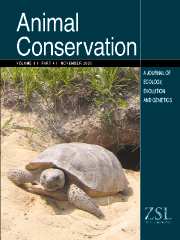Crossref Citations
This article has been cited by the following publications. This list is generated based on data provided by
Crossref.
Steel, E Ashley
Feist, Blake E
Jensen, David W
Pess, George R
Sheer, Mindi B
Brauner, Jody B
and
Bilby, Robert E
2004.
Landscape models to understand steelhead (Oncorhynchus mykiss) distribution and help prioritize barrier removals in the Willamette basin, Oregon, USA.
Canadian Journal of Fisheries and Aquatic Sciences,
Vol. 61,
Issue. 6,
p.
999.
Stranko, Scott A.
Hurd, Martin K.
and
Klauda, Ronald J.
2005.
Applying a Large, Statewide Database to the Assessment, Stressor Diagnosis, and Restoration of Stream Fish Communities.
Environmental Monitoring and Assessment,
Vol. 108,
Issue. 1-3,
p.
99.
Rice, Casimir A.
2006.
Effects of shoreline modification on a Northern Puget Sound beach: Microclimate and embryo mortality in surt smelt (Hypomesus pretiosus).
Estuaries and Coasts,
Vol. 29,
Issue. 1,
p.
63.
Borwick, Jason
Buttle, Jim
and
Ridgway, Mark S
2006.
A topographic index approach for identifying groundwater habitat of young-of-year brook trout (Salvelinus fontinalis) in the landlake ecotone.
Canadian Journal of Fisheries and Aquatic Sciences,
Vol. 63,
Issue. 2,
p.
239.
Fullerton, Aimee H.
Beechie, Timothy J.
Baker, Sarah E.
Hall, Jason E.
and
Barnas, Katie A.
2006.
Regional patterns of riparian characteristics in the interior Columbia River basin, Northwestern USA: applications for restoration planning.
Landscape Ecology,
Vol. 21,
Issue. 8,
p.
1347.
Johnson, Lyndal L.
Ylitalo, Gina M.
Arkoosh, Mary R.
Kagley, Anna N.
Stafford, Coral
Bolton, Jennie L.
Buzitis, Jon
Anulacion, Bernadita F.
and
Collier, Tracy K.
2007.
Contaminant exposure in outmigrant juvenile salmon from Pacific Northwest estuaries of the United States.
Environmental Monitoring and Assessment,
Vol. 124,
Issue. 1-3,
p.
167.
Isaak, Daniel J.
Thurow, Russell F.
Rieman, Bruce E.
and
Dunham, Jason B.
2007.
CHINOOK SALMON USE OF SPAWNING PATCHES: RELATIVE ROLES OF HABITAT QUALITY, SIZE, AND CONNECTIVITY.
Ecological Applications,
Vol. 17,
Issue. 2,
p.
352.
Budy, Phaedra
and
Schaller, Howard
2007.
EVALUATING TRIBUTARY RESTORATION POTENTIAL FOR PACIFIC SALMON RECOVERY.
Ecological Applications,
Vol. 17,
Issue. 4,
p.
1068.
Smokorowski, K.E.
and
Pratt, T.C.
2007.
Effect of a change in physical structure and cover on fish and fish habitat in freshwater ecosystems – a review and meta-analysis.
Environmental Reviews,
Vol. 15,
Issue. NA,
p.
15.
Zitek, A.
Schmutz, S.
and
Jungwirth, M.
2008.
Assessing the efficiency of connectivity measures with regard to the EU-Water Framework Directive in a Danube-tributary system.
Hydrobiologia,
Vol. 609,
Issue. 1,
p.
139.
Bilby, Robert E.
and
Mollot, Lauren A.
2008.
Effect of changing land use patterns on the distribution of coho salmon (Oncorhynchus kisutch) in the Puget Sound region.
Canadian Journal of Fisheries and Aquatic Sciences,
Vol. 65,
Issue. 10,
p.
2138.
McClure, Michelle M.
Carlson, Stephanie M.
Beechie, Timothy J.
Pess, George R.
Jorgensen, Jeffrey C.
Sogard, Susan M.
Sultan, Sonia E.
Holzer, Damon M.
Travis, Joseph
Sanderson, Beth L.
Power, Mary E.
and
Carmichael, Richard W.
2008.
Evolutionary consequences of habitat loss for Pacific anadromous salmonids.
Evolutionary Applications,
Vol. 1,
Issue. 2,
p.
300.
Beechie, Timothy J.
Pess, George R.
Pollock, Michael M.
Ruckelshaus, Mary H.
and
Roni, Phil
2009.
The Future of Fisheries Science in North America.
Vol. 31,
Issue. ,
p.
697.
JORGENSEN, JEFFREY C.
HONEA, JON M.
McCLURE, MICHELLE M.
COONEY, THOMAS D.
ENGIE, KIM
and
HOLZER, DAMON M.
2009.
Linking landscape‐level change to habitat quality: an evaluation of restoration actions on the freshwater habitat of spring‐run Chinook salmon.
Freshwater Biology,
Vol. 54,
Issue. 7,
p.
1560.
Sear, David
2010.
Salmonid Fisheries.
p.
81.
ANLAUF, KARA J.
and
MOFFITT, CHRISTINE M.
2010.
Modelling of landscape variables at multiple extents to predict fine sediments and suitable habitat for Tubifex tubifex in a stream system.
Freshwater Biology,
Vol. 55,
Issue. 4,
p.
794.
Heath, Daniel
Bettles, Cory M.
and
Roff, Derek
2010.
Environmental factors associated with reproductive barrier breakdown in sympatric trout populations on Vancouver Island.
Evolutionary Applications,
Vol. 3,
Issue. 1,
p.
77.
Wissmar, Robert C.
Timm, Raymond K.
and
Bryant, Mason D.
2010.
Radar‐Derived Digital Elevation Models and Field‐Surveyed Variables to Predict Distributions of Juvenile Coho Salmon and Dolly Varden in Remote Streams of Alaska.
Transactions of the American Fisheries Society,
Vol. 139,
Issue. 1,
p.
288.
Feist, Blake E.
Steel, E. Ashley
Jensen, David W.
and
Sather, Damon N. D.
2010.
Does the scale of our observational window affect our conclusions about correlations between endangered salmon populations and their habitat?.
Landscape Ecology,
Vol. 25,
Issue. 5,
p.
727.
Firman, Julie C.
Steel, E. Ashley
Jensen, David W.
Burnett, Kelly M.
Christiansen, Kelly
Feist, Blake E.
Larsen, David P.
and
Anlauf, Kara
2011.
Landscape Models of Adult Coho Salmon Density Examined at Four Spatial Extents.
Transactions of the American Fisheries Society,
Vol. 140,
Issue. 2,
p.
440.


